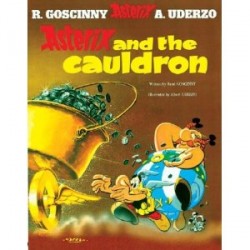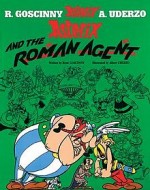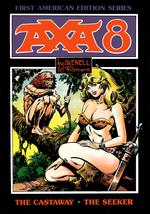
By Walt Kelly (Fantagraphics Books)
ISBN: 978-1-56097-869-5
Win’s Christmas Gift Recommendation: Perfect for anybody with a brain or heart…  10/10
This is one of those once in lifetime books which reduce honest critics to nigh speechlessness so I’m offering two different reviews: the first and most fearsomely honest is freely adapted from President’s Clinton’s election catchphrase “It’s the Economy, Stupid!â€
Ready?
Just buy it, Stupid!
If you need more though, and aren’t driven off by my unbridled brusqueness, I’ll elucidate at tedious, pointless length…
Walter Crawford Kelly Jr. was born in 1913 and started his cartooning career whilst still in High School, as both artist and reporter for the Bridgeport Post. In 1935, he moved to California and joined the Disney Studio, working on shorts and such features as Dumbo, Fantasia and Pinocchio until the infamous animator’s strike in 1941.
Refusing to take a side, Kelly moved back East and began drawing comicbooks – primarily for Dell Comics, who had the Disney funnybook license.
Despite his glorious work on such humanistic classics as the Our Gang movie spin-off, Kelly preferred anthropomorphic animal and children’s fantasy (see Walt Kelly’s Santa Claus Adventures) and created Albert the Alligator and Pogo Possum for Animal Comics #1 (December 1942) sagaciously retaining the copyrights in the ongoing tale of two Bayou critters and their young African-American pal Bumbazine. Although the black kid soon disappeared, the animal pals stayed on as stars until 1948 when Kelly became art editor and cartoonist for the hard hitting, left-leaning liberal newspaper The New York Star.
On October 4th 1948, Pogo, Albert and an ever-expanding cast began their careers in the funny pages, appearing six days a week until the periodical folded in January 1949.
Although a gently humorous kids feature, by the end of its run – reprinted in full at the back of this magnificent tome – the first glimmers of the increasingly barbed, boldly satirical masterpiece of velvet-pawed social commentary began to be seen…
This much delayed – but absolutely worth it – first of twelve volumes follows the ascent of this scintillating and vastly influential strip; don’t believe me, just listen to Gary Trudeau, Berke Breathed, Bill Watterson, Jeff McNally, Bill Holbrook, Mark O’Hare, Alan Moore, Jeff Smith and even Goscinny & Uderzo and our own Maurice Dodd & Dennis Collins, whose wonderful strip The Perishers owes more than a little to the sublime antics of the Okefenokee Swamp citizenry…
After the Star closed Pogo was picked up for mass distribution by the Post-Hall Syndicate and launched on May 16th 1949. A colour Sunday page debuted January 29th 1950 and both were produced simultaneously by Kelly until his death in 1973 (and beyond, courtesy of his talented wife and family…).
At its peak the strip appeared in 500 papers in 14 countries and the book collections which began in 1951 numbered nearly 50, collectively selling 30 million copies.
This volume includes all the Star strips, the Dailies from inception to December 30th 1950, and the Sundays – in a full colour section – from January 29th – December 31st 1950, plus a wealth of supplementary features including a Foreword from columnist Jimmy Breslin, an introduction by biographer Steve Thompson, a week-by-week highly detailed contents section, a useful guide ‘About the Sundays’ by Mark Evanier, and an invaluable context and historical notes feature ‘Swanp Talk’ by the amazing R.C. Harvey.
Kelly’s genius was the ability to beautifully, vivaciously draw comedic, tragic, pompous, sympathetic characters of any shape or breed and make them inescapably human and he used that gift to blend hard-hitting observation of our crimes, foibles and peccadilloes with rampaging whimsy, poesy and sheer exuberant joie de vivre.
The hairy, scaly, feathered slimy folk here are inescapably us, elevated by burlesque, slapstick, absurdism and all the glorious joys of wordplay from puns to malapropisms to raucous accent humour into a multi-layered hodge-podge of all-ages accessible delight.
In volumes to come Kelly will set his bestial cast loose on such timid, defenceless victims as Senator Joe McCarthy, J.Edgar Hoover, the John Birch Society, Richard Nixon and the Ku Klux Clan, but he starts off small here, introducing the gently bemused Pogo, boisterous, happily ignorant Albert, dolorous Porkypine, obnoxious turtle Churchy La Femme, lugubrious hound Beauregard Bugleboy, carpet-bagging Seminole Sam Fox, pompous (not) know-it-all Howland Owl and a host of others in gags and extended epics ranging from assorted fishing trips, building an Adam Bomb, losing and finding other people’s children, electioneering, education, kidnapping, the evil influence of comicbooks, Baseball season, why folks shouldn’t eat each other, Western cow punchers, cows punching back, New Years Resolutions, public holidays and so much more…
The Sundays also began with one-off gags but soon evolved into convoluted and mesmeric continued sagas such as the search for the Fountain of Youth, building a school and keeping it filled, Albert being elected Queen of the Woodland by the elf-like forest fauns – and why that was ultimately a very bad thing indeed…
Timeless and magical, Pogo is a giant of world literature, not simply comics, and this magnificent edition should be the pride of every home’s bookshelf.
POGO Through the Wild Blue Wonder and all POGO images, including Walt Kelly’s signature © 2011 Okefenokee Glee & Perloo Inc. All other material © 2011 the respective creator and owner. All rights reserved.












